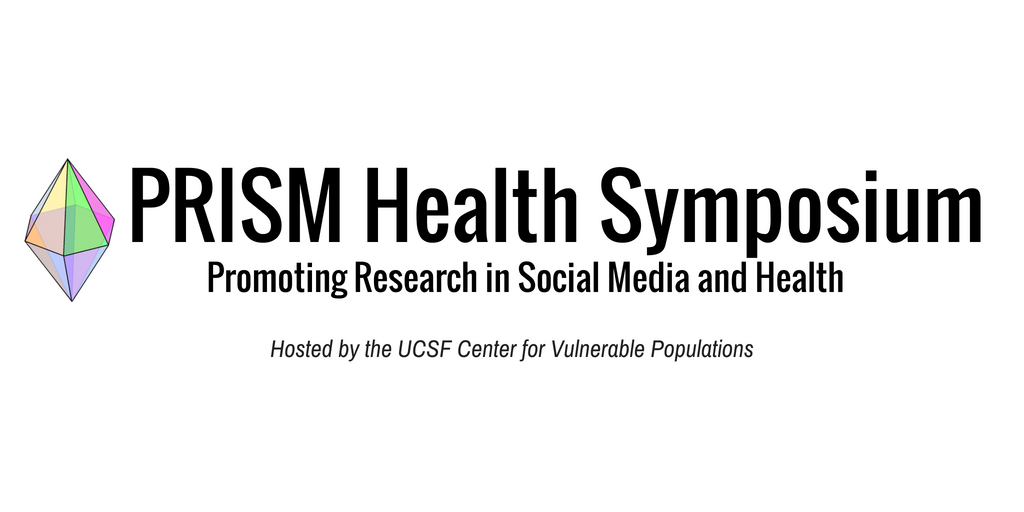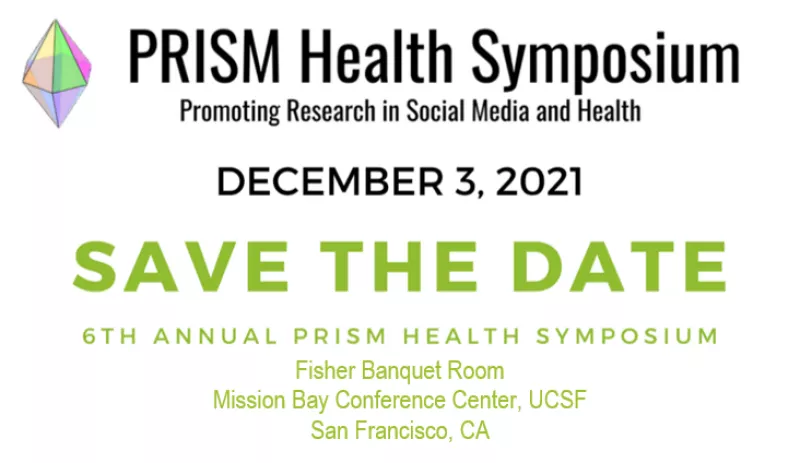PRISM 2021 Attendance Survey
Planning on joining us in San Francisco for the in-person PRISM Health Symposium? Won’t be able to attend? Fill out our attendance survey or visit bit.ly/attend-prism! Please share with folks you think may be interested in attending.
Opportunities
Project Assistant
The Social Media Analytics (SOMA) Lab at the Keck School of Medicine of USC is seeking a full-time Project Assistant. Directed by PRISM Co-Chair, John-Patrick Allem, PhD, the SOMA Lab studies topics at the intersection of public health, communication, and marketing. This position would be great for a recent college graduate looking to gain experience in a research setting and/or for someone thinking about applying to graduate school in the future.
Social Media Data for Public Health and Policy, International Journal of Environmental Research and Public Health
The submission deadline to Special Issue, "Social Media Data for Public Health and Policy" in the International Journal of Environmental Research and Public Health is on September 1, 2021. The Special Issue is edited by John-Patrick Allem, PhD and Anuja Majmundar, PhD. Papers are published online on a rolling basis.
Commentaries
COVID-19 vaccine selfie: a modest endeavor to increase vaccine acceptance
To encourage greater vaccine acceptance among social media users, this commentary argues that taking selfies while receiving the COVID-19 vaccine has the potential to motivate others to do so. These COVID-19 vaccine selfies highlight health, joy, and optimism, which may positively improve public response to the vaccines. By sending a message to anti-vaxxers that the vaccines are safe and effective, sharing your vaccine selfies online can be a powerful tool.
The COVID-19 Misinfodemic: Moving Beyond Fact-Checking
Co-authored by PRISM Steering Committee Member, Wen-Ying Sylvia Chou, PhD, MPH,this commentary argues that although necessary, fact-checking efforts by public health organizations to counter COVID-19 misinformation are insufficient. In the context of the pandemic, there are several factors that drive misinformation sharing and acceptance, such as distrust, cognitive biases, emotions, racism, and xenophobia. Additional measures beyond fact-checking include enhancing the public’s health and science literacy, encouraging people to be mindful about the content they read and share, leveraging clinician relationships with patients to educate them about misinformation, and highlighting ulterior motives and techniques used by misinformation agents.
Identifying Credible Sources of Health Information in Social Media: Principles and Attributes
Convened by the National Academy of Medicine, Wen-Ying Sylvia Chou, PhD, MPH and other members of an independent advisory group developed a set of initial principles and attributes that could inform social media platforms’ identification and possible elevation of credible sources of health information. Using these as a framework, the authors discuss the likelihood of credibility among major types of nonprofit and government organizations that share health information through social media. In addition to source and content evaluation, the need for parallel strategies and ethical considerations (e.g. protection of free speech, individual autonomy) is emphasized. In order to be considered credible themselves, social media platforms should share data with behavioral and public health researchers to understand the effects of such policies on both online and offline behaviors.
Recent Social Media and Health Publications
Bardier C, Yang JS, Li J, Mackey TK. Characterizing alternative and emerging tobacco product transition of use behavior on Twitter. BMC Res Notes. 2021 Aug 9;14(1):303. doi: 10.1186/s13104-021-05719-0. PMID: 34372926; PMCID: PMC8351350.
Co-authored by PRISM Steering Committee Member, Tim K. Mackey, PhD, MAS, this study aimed to develop an inductive coding approach to characterize user-generated social media conversations about transition of use of different tobacco and alternative and emerging tobacco products (ATPs). Using data mining approaches, collected geocoded tweets were filtered for keywords associated with tobacco and ATP use behavior. This resulted in a subset of 5718 tweets, with 657 manually annotated and identified as associated with user-generated conversations about tobacco and ATP use behavior. These tweets were coded into 9 parent codes, with the highest number of observations occurring under transition of use (43.38%), current use (39.27%), opinions about use (0.07%), and product promotion (0.06%). These results provide early insights into how social media users discuss topics related to transition of use and their experiences with different and emerging tobacco product use behavior.
Nguyen TT, Huang D, Michaels EK, Glymour MM, Allen AM, Nguyen QC. Evaluating associations between area-level Twitter-expressed negative racial sentiment, hate crimes, and residents' racial prejudice in the United States. SSM Popul Health. 2021;13:100750. doi:10.1016/j.ssmph.2021.100750. PMID: 33665332. PMCID: PMC7901034.
To investigate whether an area-level measure of racial sentiment derived from Twitter data is associated with state-level hate crimes and existing measures of racial prejudice at the individual-level, PRISM Steering Committee Member, Thu T. Nguyen, ScD, MSPH, and her co-authors collected tweets from June 2015-July 2018 containing at least one keyword pertaining to specific racial groups. They characterized sentiment of each tweet and averaged at the state-level. These racial sentiment measures were merged with other measures based on hate crime data, implicit and explicit racial bias indicators, and racial attitudes questions. Living in a state with 10% higher negative sentiment in tweets referencing Black people was associated with 0.57 times the odds of agreement that Black-White disparities in jobs, income, and housing were due to discrimination; 1.64 times the odds of endorsing the belief that disparities were due to lack to will; higher explicit racial bias; and higher implicit racial bias.
Gaysynsky A, Rising CJ, Trivedi N, Blake KD, Chou WS, Oh A, Vanderpool RC. Communication research at the National Cancer Institute, 2013-2019: a grant portfolio analysis. Cancer Causes Control. 2021 Jul 27. doi: 10.1007/s10552-021-01481-7. Epub ahead of print. PMID: 34313875.
To provide insight into the characteristics of projects funded by the National Cancer Institute (NCI) and identify promising areas for future research, Wen-Ying Sylvia Chou, PhD, MPH, and co-authors analyzed communication-focused grants between fiscal years 2013 and 2019. Of the communication grants identified, most focused on cancer prevention (n = 197), tobacco product use (n = 128), and outcomes at the individual (n = 332) or interpersonal level (n = 127). Cancer patients/survivors (n = 101) and healthcare providers (n = 63) were often the population of focus. Few studies were based in schools or worksites, more often being based in healthcare settings (n = 125). Many grants employed randomized controlled trials (n = 168), but more novel methods were uncommon. This analysis points to promising future research opportunities, including efforts focused on communication at later stages of the cancer control continuum and at multiple levels of influence, as well as a greater diversity of settings and novel methodological approaches.
Chou WS, Gaysynsky A, Trivedi N, Vanderpool RC. Using Social Media for Health: National Data from HINTS 2019. J Health Commun. 2021 Mar 4;26(3):184-193. doi: 10.1080/10810730.2021.1903627. Epub 2021 Apr 15. PMID: 33856286.
Co-authored by Wen-Ying Sylvia Chou, PhD, MPH, this study describes current prevalence and predictors of social media (SM) use by analyzing nationally representative data from the 2019 Health Information National Trends Survey (HINTS). Multivariate logistic regression models examined the odds of engaging in four SM activities: visiting social networking sites, sharing health information on SM, participating in online support groups, and watching health-related videos. In 2019, approximately 86% of Internet users reported engaging in at least one SM activity. Younger age and female gender were associated with higher likelihood of engaging in all SM activities. No significant ethnic/racial disparities were observed for most activities, but Hispanic people were found to be more likely to report watching health-related videos. Additionally, those with regular health care access were more likely to participate in online support groups.
Allem J, Dormanesh A, Majmundar A, Rivera V, Chu M, Unger JB, Cruz TB. Leading Topics in Twitter Discourse on JUUL and Puff Bar Products: Content Analysis. J Med Internet Res 2021;23(7):e26510. doi: 10.2196/26510. PMID: 34279236
In response to the recent government restrictions, flavored JUUL products, which are rechargeable closed-system electronic cigarettes (e-cigarettes), are no longer available for sale. However, disposable closed-system products, such as the flavored Puff Bar e-cigarette, continue to be available. If e-cigarette consumers simply switch between products during the restrictions, these restrictions would be less effective. To understand how the public discusses these products, Jon-Patrick Allem, PhD and co-authors examined public discourse on Twitter that referenced both Puff Bar and JUUL products. Using an inductive approach, the group generated a codebook to identify common themes among tweets gathered from Twitter’s streaming API. Posts often mentioned flavors, dual use, design features, youth use, health risks, switching one product for the other, price, confusion over the differences between products, longevity of the products, and nicotine concentration.
Allem J, Dormanesh A, Majmundar A, Unger JB, Kirkpatrick MG, Choube A, Aithal A, Ferrara E, Boley Cruz T. Topics of Nicotine-Related Discussions on Twitter: Infoveillance Study. J Med Internet Res 2021;23(6):e25579. doi: 10.2196/25579. PMID: 34096875. PMCID: 8218215
Co-authored by Jon-Patrick Allem, PhD, the goal of this study was to identify and describe nicotine-related topics of conversation authored by the public and social bots on Twitter, including any misinformation or misconceptions that health education campaigns could potentially correct. Twitter posts containing the term “nicotine” were obtained from September 30, 2018 to October 1, 2019. Posts from social bots were identified and separated from the final data. Prevalent topics of posts included vaping, smoking, addiction, withdrawal, nicotine health risks, and quit nicotine, with mentions of going “cold turkey” and needing help in quitting. Cessation was a common topic, with mentions of quitting and stopping smoking. Social bots discussed unsubstantiated health claims including how hypnotherapy, acupuncture, magnets worn on the ears, and time spent in the sauna can help in smoking cessation.
Purnat TD, Vacca P, Czerniak C, Ball S, Burzo S, Zecchin T, Wright A, Bezbaruah S, Tanggol F, Dubé È, Labbé F, Dionne M, Lamichhane J, Mahajan A, Briand S, Nguyen T. Infodemic Signal Detection During the COVID-19 Pandemic: Development of a Methodology for Identifying Potential Information Voids in Online Conversations. JMIR Infodemiology 2021;1(1):e30971. doi: 10.2196/30971
Members of the World Health Organization (WHO) and co-authors, this study aimed to develop a practical, structured approach to identify narratives in public online conversations on social media platforms where concerns or confusion exist, or where narratives are gaining traction, thus providing actionable data to help the WHO prioritize its response efforts to the COVID-19 infodemic. This study developed a taxonomy to filter global public conversations related to COVID-19 on social media. Quantitative data were used to provide insights on emerging narratives, influencers, and public reactions to COVID-19–related topics. A weekly analysis of public online conversations since March 23, 2020, enabled quantification of shifting interests in public health–related topics concerning the pandemic, and the analysis demonstrated recurring voids of verified health information. This approach therefore focuses on the detection of infodemic signals to generate actionable insights to rapidly inform decision-making for a more targeted and adaptive response, including risk communication.
Hear from the authors in this video.

